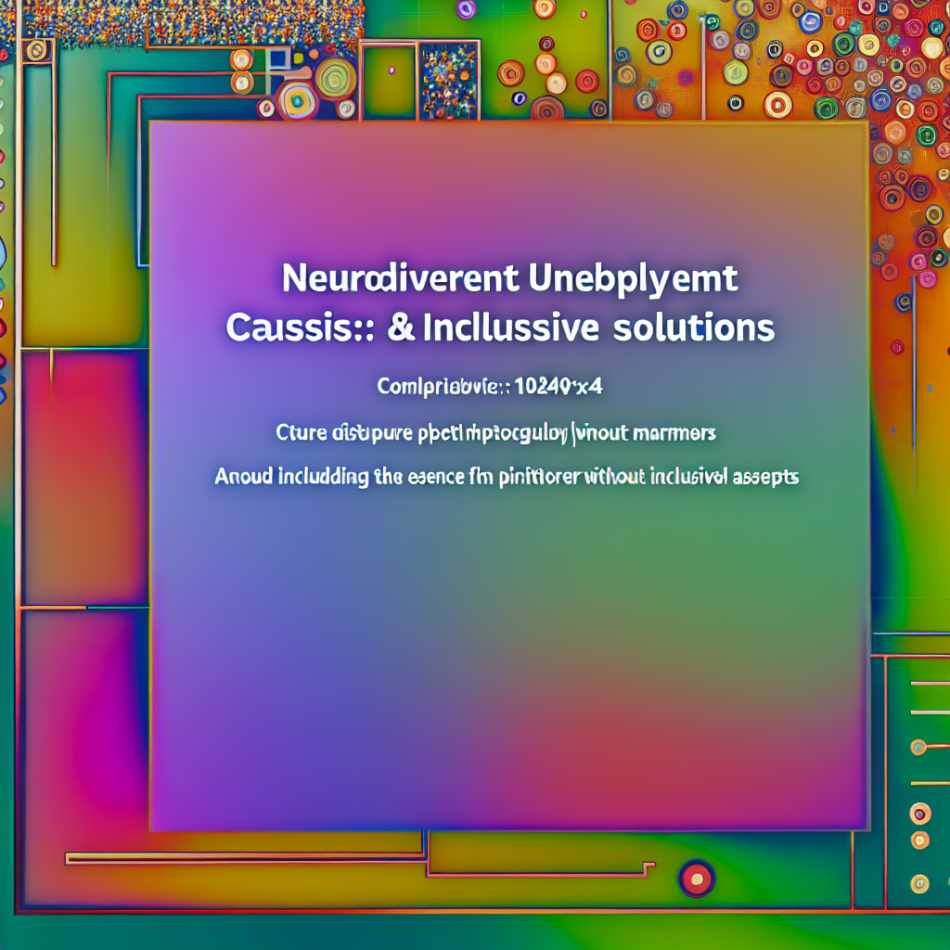Neurodivergent Adults and the Unemployment Crisis: A Hidden Workforce Challenge
Neurodivergent adults—including those with autism, ADHD, dyslexia, and other neurological differences—face alarmingly high unemployment rates compared to the general population. Even individuals with advanced qualifications struggle to secure or retain employment, highlighting systemic barriers in workplaces worldwide. This article explores the root causes of this disparity, dismantles misconceptions, and offers actionable solutions to create more inclusive, equitable opportunities for neurodivergent talent.
The Stark Reality of Neurodivergent Unemployment
Studies consistently reveal that neurodivergent adults experience unemployment rates three to four times higher than neurotypical peers. In the UK, for instance, only 22% of autistic adults are employed, despite many possessing degrees or specialised skills. This gap persists across sectors, from technology to healthcare, suggesting a widespread failure to harness neurodivergent strengths, such as pattern recognition, attention to detail, and innovative problem-solving.
Common factors contributing to this crisis include:
- Traditional recruitment processes that disadvantage neurodivergent candidates (e.g., unstructured interviews or sensory-overloading assessment centres)
- Lack of workplace adjustments, such as flexible communication styles or sensory-friendly environments
- Employer bias stemming from misunderstandings about neurodiverse capabilities
Barriers Beyond Qualifications: Why Skills Alone Aren’t Enough
While qualifications matter, neurodivergent individuals often face invisible hurdles. For example, executive functioning challenges—common in ADHD—can make rigid scheduling or multitasking-heavy roles overwhelming, even for highly educated professionals. Similarly, autistic adults might excel in technical roles but struggle with ambiguous social expectations in team settings. These mismatches are rarely addressed through training programmes or corporate diversity initiatives, which frequently focus on visible disabilities.
Moreover, stigma plays a pivotal role. Many neurodivergent adults report “masking” their traits to fit into neurotypical workplace cultures, leading to burnout and mental health declines. This pressure to conform forces talented individuals out of jobs they are otherwise qualified to perform.
Employer Misconceptions and the Cost of Exclusion
A pervasive myth is that accommodating neurodivergent employees is costly or disruptive. In reality, simple adjustments—like providing noise-cancelling headphones or written task instructions—often yield significant productivity gains. Companies like Microsoft and SAP have pioneered neurodiversity hiring programmes, reporting 30-50% higher productivity in roles such as data analysis and cybersecurity compared to neurotypical teams.
Another misconception is that neurodivergent employees require constant supervision. In truth, many thrive in autonomous roles when given clear expectations. However, employers frequently overlook these opportunities due to rigid job descriptions or a lack of awareness about neurodiverse strengths.
Building Inclusive Workplaces: Strategies That Work
Addressing neurodivergent unemployment requires systemic change. Forward-thinking organisations are adopting strategies such as:
- Skills-based hiring: Prioritising task demonstrations over CV gaps or interview performance
- Tailored onboarding: Assigning mentors and providing role-specific social scripts
- Flexible environments: Offering remote work options or sensory-adjusted office spaces
Government initiatives also play a role. The UK’s Disability Confident Scheme encourages employers to recruit and retain disabled workers, including neurodivergent individuals. However, uptake remains inconsistent, with many businesses lacking the expertise to implement these frameworks effectively.
The Role of Education and Advocacy in Closing the Gap
Educational institutions must better prepare neurodivergent students for workplace realities. Universities like Sheffield Hallam have introduced autism-specific career coaching, helping graduates navigate job searches and disclosure decisions. Meanwhile, advocacy groups—such as the National Autistic Society—are pushing for policy reforms, including mandatory neurodiversity training for hiring managers and subsidies for workplace adjustments.
Individuals, too, can drive change. Neurodivergent professionals are increasingly sharing their experiences via LinkedIn and industry panels, challenging stereotypes and showcasing the value of cognitive diversity in driving innovation.
A Call to Redefine Workplace Potential
The unemployment crisis among neurodivergent adults isn’t just a social justice issue—it’s a missed economic opportunity. By rethinking recruitment, fostering inclusive cultures, and amplifying neurodiverse voices, employers can tap into a vast, underutilised talent pool. Progress demands collaboration: policymakers must incentivise inclusivity, educators must bridge the skills-to-workforce gap, and businesses must move beyond token gestures to meaningful systemic change. The result? Workplaces where neurological differences aren’t just accommodated but celebrated as catalysts for growth.
